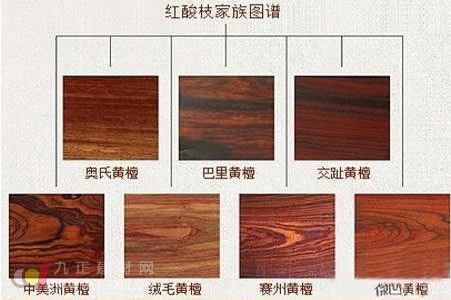As a major category in the "Redwood" national standard, the red rosewood family has many members, including Sian rosewood, A. sinensis, Diphong Dalbergia, Bari Dalbergia, Sai Dang, Sandalwood, and Central American Dalbergia. Seven species. How to identify these different kinds of red rosewoods? What are the wood characteristics of each of them? This article cuts into the types of red rosewood, and shows the readers a detailed map of the family of red rosewood.
Red rosewood is the mainstream material for domestic mahogany furniture production. It is sought after by mahogany furniture lovers due to its good wood quality, large stock and reasonable price. However, since the red rosewoods cover a large variety of woods, the appearance of red rosewood woods of different tree species is relatively close, and there is no small difference in price, thus, the purchase of red rosewood furniture for consumers brings A lot of confusion.
At the same time, from the point of view of existing scientific identification methods, it is difficult to identify specific tree species by wood samples only when additional leaf specimens are not provided. In other words, it is difficult to determine a red rosewood by scientific experiment. It depends on the species of Dalbergia, Dalbergia or other red rosewood. Therefore, for consumers, mastering the basic identification method has become a good homework to buy red rosewood furniture.

Wood Industry Information Network Data Map: Detailed Explanation of Red Rose Family Map
For the definition of red rosewood, several prerequisites are specified in the "Redwood" national standard:
Dalbergia tree species;
The structure of the wood is fine to very fine, and the average tube hole chord diameter is not more than 200 μm;
When the wood moisture content is 12%, the air dry density is greater than 0.85g/cm3;
Heartwood reddish brown wood color wood to purple.
At the same time, it is also described in the red rosewood tree species and its wood characteristics: the growth wheel type is a loose hole material to a semi-diffuse hole material, the heart material is reddish brown or purple reddish brown, and the axial thin wall tissue is concentric layer thin line or Narrow band shape, fine structure, air dry density is very large, wave marks are visible or obvious, acid aroma or very weak, the main producing area is tropical. And it is indicated in the remarks that the majority of the red rosewood sinks in the water, and the stripe pattern is often formed on the radial cut surface due to the texture interlacing.
Through this description, we have a simple understanding of the red rosewood, and at the same time, through the horizontal comparison of the seven red rosewood, we can conclude that:
First of all, the red rosewood must be a species of Dalbergia. Dalbergia is one of the five genera and eight species in the national standard of "Redwood". The other four are P. genus, genus, genus, and persimmon, while Dalbergia contains three Wood, fragrant wood, black rosewood, and the main character of this article are red rosewood. Among the Dalbergia genus, the most prestigious is the fragrant rosewood in the fragrant wood, which is commonly known as Hainan huanghuali, and the red rosewood is the most widely used.
Secondly, from the scope of use of red rosewood, the most popular and most popular red rosewood is Sian rosewood, followed by dimpled Dalbergia, A. sinensis, and Bari Dalbergia. Successively, the three species of Saizhou Dalbergia, F. rosewood and Central American Dalbergia are rarely used in China.
Third, from the perspective of timber distribution, Laos, Myanmar, Cambodia, South America and Mexico in Southeast Asia are the main producing areas of red rosewood, except for Dalbergia, A. serrata and Bare Dalbergia, which are produced in Southeast Asia. The rest are produced in South America and Mexico.
Fourth, as the history of Chinese hardwood furniture material point of view, Cochin rosewood and rosewood with traditional Barry oldest, followed by Albright, finally produced the dimpled rosewood Americas.
Fifth, from wood color point of view, due to differences in origin, produced in Southeast Asia, Cochin rosewood, Albright and Barry rosewood mostly purple new section reddish brown or reddish-brown, slightly concave rosewood and produced in South America and Mexico, state tournament rosewood, rosewood and fluff in addition to the Central American rosewood mahogany red wood timber often, the new section will appear
Finally, under the same conditions from the point of view air-dry density, air-dry density is the largest Massachusetts rosewood, was 1.20g / cm3, is greater than Barry rosewood Cochin rosewood, Dalbergia slightly concave usually greater than Albright.
Chisels are classified in different shapes according to different uses:
Flat chisel: the cutting edge is flat, the cutting edge and the chisel body is an inverted isosceles triangle, mainly used for opening square holes or repairing some square holes;
Oblique chisel: the blade is 45° Angle, the blade and chisel body is an inverted right triangle, mainly used for repair, most of the dead corners for carving and carving repair;
Gouge: the cutting edge is semicircular, mainly used for opening circular or elliptical holes;
U type chisel: the cutting edge is U-shaped, which is rare now, mainly used for carving and repair;
Chisel,chisel for hammer drill,chisel for stone,impact chisel,stone chisel
Behappy Crafts (suzhou)Co.,Ltd , https://www.craftsbehappy.com